Solar generators are gaining popularity as an eco-friendly and reliable power solution. Whether you’re an outdoor enthusiast, preparing for emergencies, or just looking to reduce your carbon footprint, a solar generator can be a valuable investment. Here, we review the 7 best solar generators for 2024, highlighting their specifications, features, and why they stand out.
1. Anker SOLIX C1000
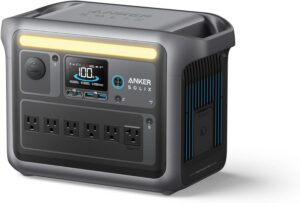
The Anker SOLIX C1000 is a high-performance portable power station designed to meet a range of power needs, from camping trips to emergency backup. With its sleek design and robust feature set, it’s a solid choice for anyone needing reliable power on the go.
Key Features
- Capacity: With a 1000Wh (277,000mAh) capacity, the SOLIX C1000 provides ample power to keep multiple devices running simultaneously.
- Output Ports: It offers a variety of output options, including AC outlets, USB-A, USB-C, and DC ports, allowing it to charge or power a wide range of devices.
- Fast Charging: The power station supports fast charging technology, enabling quicker recharging of the unit itself, as well as faster output to connected devices.
- Portable Design: The SOLIX C1000 features a compact and ergonomic design with a built-in handle, making it easy to transport.
- Durability: Built with high-quality materials, it is designed to withstand rugged environments, making it suitable for both indoor and outdoor use.
Specifications:
| Specification | Details |
|---|---|
| Battery Capacity | 1000Wh (277,000mAh) |
| AC Output | 2 x 120V AC outlets, 1000W (2000W peak) |
| USB-A Output | 2 x 18W USB-A ports |
| USB-C Output | 1 x 60W USB-C port |
| DC Output | 1 x 12V DC carport |
| Input Options | AC adapter, solar panel |
| Dimensions | 14.2 x 8.7 x 10.2 inches |
| Weight | 21.8 lbs (9.9 kg) |
| Operating Temperature Range | 32°F to 104°F (0°C to 40°C) |
| Warranty | 1 year |
Pros
- Versatile with multiple output options.
- High capacity for extended use.
- Compact and portable design.
- Fast charging capabilities.
Cons
- On the heavier side compared to smaller models.
- Higher price point may be a consideration for budget-conscious buyers.
The Anker SOLIX C1000 stands out as a powerful and versatile portable power station. Its high capacity, multiple output options, and durable build make it a great choice for both casual users and those with more demanding power needs. While it may be on the heavier side, its performance and features justify the investment for anyone seeking reliable power in a portable format.
2. Jackery Explorer 2000 Pro
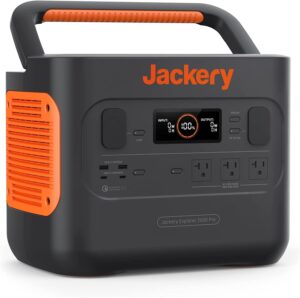
The Jackery Explorer 2000 Pro is a high-capacity portable power station designed for both outdoor adventures and emergency backup. It boasts an impressive battery capacity and a variety of output options, making it a versatile choice for powering appliances, electronics, and tools on the go.
Key Features
- High Capacity: With a 2,160Wh lithium-ion battery, the Explorer 2000 Pro offers substantial power for extended use.
- Powerful Output: The unit features a 2,200W pure sine wave inverter with a surge capacity of 4,400W, ensuring compatibility with a wide range of devices and appliances.
- Multiple Ports: It includes 3 AC outlets, 2 USB-C ports, 2 USB-A ports, and 1 carport, providing flexible charging options for various devices.
- Fast Recharging: The Explorer 2000 Pro can be recharged via AC power, carport, or solar panels, with a maximum input power of 800W for quicker recharge times.
- Portable Design: Equipped with wheels and an extendable handle, it’s designed for easy transport despite its large capacity.
Specifications:
| Feature | Details |
|---|---|
| Battery Capacity | 2,160Wh |
| Inverter Output | 2,200W (Surge 4,400W) |
| AC Outlets | 3 |
| USB-C Ports | 2 (100W each) |
| USB-A Ports | 2 (18W each) |
| Carport | 1 (12V/10A) |
| Recharge Options | AC, Solar (max 800W), Carport |
| Dimensions | 15.3 x 10.4 x 12.4 inches |
| Weight | 43.1 lbs |
Pros
Large Capacity: With a 2,160Wh battery, it can power multiple devices and appliances for extended periods.
Versatile Charging Options: Offers various output ports and supports fast recharging through AC, solar, or carport.
High Output: The 2,200W inverter with 4,400W surge capacity can handle most household appliances and power tools.
Portability: The built-in wheels and handle make it easy to move despite its size and weight.
User-Friendly Display: The LCD screen provides clear information on battery status, input/output power, and remaining usage time.
Cons
- Price: The Explorer 2000 Pro is on the higher end of the price spectrum for portable power stations.
- Weight: At 43.1 lbs, it may be cumbersome for some users to carry, even with the wheels.
- Recharge Time: While it supports fast recharging, achieving a full charge can still take several hours depending on the method used.
- Size: Its large dimensions may be less suitable for those with limited storage space.
Overall, the Jackery Explorer 2000 Pro is a robust and efficient power solution, combining high capacity and versatility with a user-friendly design. It’s an excellent choice for those who need reliable, high-capacity portable power, though its price and size may be considerations for potential buyers.
3. EcoFlow Delta Max
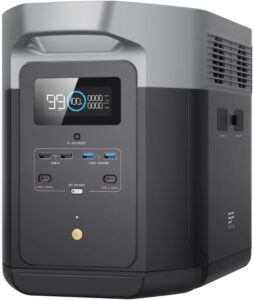
The EcoFlow Delta Max is a powerful portable power station designed for high-capacity energy needs. Ideal for both outdoor adventures and emergency backup, the Delta Max combines high output with versatility, making it a popular choice for those requiring a reliable and robust power source.
Key Features
- High Capacity: With a massive 2,016Wh battery capacity, the Delta Max can power a wide range of devices for extended periods, including refrigerators, power tools, and more.
- Impressive Output: It offers a peak output of 3,400W, which is sufficient to handle most high-power appliances. Its multiple AC outlets allow for versatile use.
- Fast Recharging: The Delta Max can be recharged from 0% to 80% in just 65 minutes using a standard wall outlet, thanks to its X-Stream charging technology.
- Multiple Ports: It includes a range of ports including AC outlets, USB-A and USB-C ports, and DC carports, ensuring compatibility with various devices.
- Smart Features: The EcoFlow app allows for remote monitoring and control of the power station. It also features a real-time battery and usage monitoring system.
Specifications
| Feature | Specification |
|---|---|
| Battery Capacity | 2,016Wh |
| Peak Output | 3,400W |
| AC Output Ports | 4 x AC outlets (110V) |
| USB-A Ports | 2 x 12W |
| USB-C Ports | 2 x 100W |
| DC Carport | 1 x 12V/10A |
| Recharging Time | 0% to 80% in 65 minutes |
| Weight | 48.4 lbs (22 kg) |
| Dimensions | 18.1 x 12.6 x 12.8 inches |
| Operating Temp | 14°F to 104°F (-10°C to 40°C) |
| Warranty | 24 months |
Pros
- High Capacity: Large 2,016Wh battery capacity supports extended use and powers a variety of devices.
- High Output: 3,400W peak output accommodates high-power appliances and tools.
- Fast Charging: Rapid recharging from 0% to 80% in just 65 minutes ensures quick turnaround times.
- Versatile Ports: Multiple AC, USB-A, USB-C, and DC ports provide flexible power options.
- Smart Control: Remote monitoring and control via the EcoFlow app add convenience and functionality.
Cons
- Weight: At 48.4 lbs, it may be cumbersome to transport, especially for extended trips.
- Price: The Delta Max is on the higher end of the price spectrum for portable power stations.
- Size: Its large size may be challenging to fit into smaller spaces or vehicles.
- Operating Temperature: Limited operating temperature range might affect performance in extreme climates.
The EcoFlow Delta Max stands out for its powerful output, high capacity, and fast recharging capabilities. While it may be heavier and more expensive compared to some alternatives, its robust features and versatility make it a valuable choice for both outdoor enthusiasts and those preparing for emergencies.
4. Bluetti AC200L
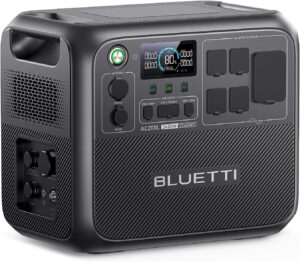
The Bluetti AC200L is a versatile and powerful portable power station designed for outdoor adventures and emergency situations. With its impressive capacity and robust features, it’s a popular choice for those needing reliable off-grid power.
Key Features
- Capacity: 2,000Wh Power Output: 2,200W (surge 4,800W)
- Battery Type: Lithium Iron Phosphate (LiFePO4)
- Solar Input: Up to 700W (12-35V/10A)
- Charging Time: 3-4 hours via AC, 3-4 hours via solar Weight: 57 lbs (26 kg)
- Display: LCD screen for battery status and settings
Specification Table
| Specification | Details |
|---|---|
| Capacity | 2,000Wh |
| Power Output | 2,200W (surge 4,800W) |
| Battery Type | Lithium Iron Phosphate (LiFePO4) |
| AC Outlets | 4 x 110V AC |
| DC Car Ports | 2 x 12V/10A |
| USB Ports | 2 x USB-A (5V/3A), 1 x USB-C (100W PD) |
| Solar Input | Up to 700W (12-35V/10A) |
| Charging Time | 3-4 hours (AC/Solar) |
| Weight | 57 lbs (26 kg) |
| Dimensions | 16.5 x 11 x 15.2 inches (42 x 28 x 38 cm) |
| Display | LCD screen |
Pros
- High Capacity: 2,000Wh capacity provides ample power for most applications, including larger appliances.
- Versatile Output: Multiple output options, including AC, DC, and USB ports, cater to a wide range of devices.
- Durable Battery: Lithium Iron Phosphate battery offers longer life and better safety compared to other battery types.
- Fast Charging: Can be charged quickly through AC or solar power, adding flexibility for recharging.
- Portable Design: Despite its large capacity, it’s designed to be portable, suitable for camping or emergency use.
Cons
- Weight: At 57 lbs, it may be heavy for some users to carry over long distances or for frequent transport.
- Size: Its dimensions might be bulky for certain storage spaces or vehicle trunks.
- Price: Higher capacity and features come at a premium price, which may be a consideration for budget-conscious buyers.
- Noise: The fan can be somewhat noisy when the unit is under heavy load or during charging.
The Bluetti AC200L is a robust and high-capacity power station that excels in providing reliable power in a variety of situations. Its versatile output options and fast charging capabilities make it a strong choice for both outdoor activities and emergency power needs, though its weight and cost may be factors to consider.
5. Anker SOLIX C800
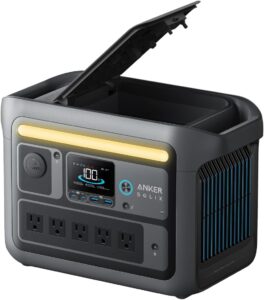
The Anker SOLIX C800 is a high-performance solar charger designed to offer reliable power solutions for outdoor enthusiasts and off-grid living. With advanced technology and robust build quality, it ensures efficient energy conversion and durability.
Key Features
- High Efficiency Solar Panels: Utilizes monocrystalline solar technology for superior energy conversion and performance.
- Power Output: Delivers up to 100W of power, sufficient for charging larger devices such as laptops.
- Multiple Ports: Equipped with a USB-C, USB-A, and DC output for versatile charging options.
- Foldable and Portable: Compact, foldable design for easy storage and transport.
- Durability: IPX4 water resistance and heat-resistant materials ensure reliable performance in various weather conditions.
Specifications
| Feature | Details |
|---|---|
| Type | Portable Solar Charger |
| Power Output | 100W (20V/5A) |
| Solar Panel Type | Monocrystalline |
| Charging Ports | 1 x USB-C, 1 x USB-A, 1 x DC Output |
| Foldable Design | Yes |
| Dimensions (Folded) | 11.4 x 7.5 x 1.2 inches (29 x 19 x 3 cm) |
| Dimensions (Unfolded) | 28.3 x 11.4 inches (72 x 29 cm) |
| Weight | 1.98 lbs (0.9 kg) |
| Durability | IPX4 Water Resistant, Heat Resistant |
| Compatibility | Smartphones, Tablets, Laptops, Small Appliances |
| Included Accessories | DC to Cigarette Lighter Adapter, USB-C to USB-C Cable |
Pros
- Efficient Charging: High conversion efficiency allows for faster and more reliable charging.
- Versatility: Multiple ports support a wide range of devices.
- Portable Design: Foldable and lightweight, ideal for travel and outdoor use.
- Durable Build: Withstands light rain and high temperatures, making it suitable for various environments.
- Ease of Use: Simple setup and operation, compatible with most electronic devices.
Cons
- Weight: Slightly heavy compared to some ultra-light alternatives, which might be cumbersome for long backpacking trips.
- Price: Higher cost compared to basic solar chargers, which might not fit every budget.
- Limited Power for Larger Appliances: While it can handle small appliances, it might not be sufficient for high-power devices or prolonged use.
Overall, the Anker SOLIX C800 is a durable and efficient solar charger that balances performance and portability, making it a strong contender in the portable solar power market.
6. DJI Power 1000
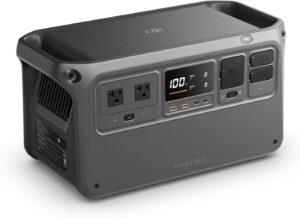
The DJI Power 1000 is a robust power solution designed to meet the needs of professionals who demand reliability and high performance. This power bank is engineered to deliver consistent and efficient power for your devices, whether you’re on the go or in a studio setting. With a focus on durability and capacity, the Power 1000 stands out in the market of high-capacity power solutions.
Key Features
- High Capacity: Equipped with a substantial 1000Wh battery, the Power 1000 offers extended power for a variety of devices and applications.
- Versatile Outputs: Multiple output options including AC, DC, and USB ports ensure compatibility with a wide range of devices.
- Advanced Battery Management: Incorporates advanced battery management technology for enhanced safety and longevity.
- Compact and Portable: Despite its high capacity, the Power 1000 maintains a relatively compact and portable design for easy transport.
- Intelligent LCD Display: Features an intuitive LCD display that provides real-time information on power levels, output status, and battery health.
Specification
| Feature | Specification |
|---|---|
| Battery Capacity | 1000Wh |
| AC Output | 2 x 110V AC, 1000W (Peak 2000W) |
| DC Output | 12V, 10A |
| USB Output | 2 x USB-A, 5V/2.4A each |
| DC Input | 12V-30V, 150W max |
| Weight | 8.5 kg (18.7 lbs) |
| Dimensions | 28 x 18 x 18 cm (11 x 7 x 7 in) |
| Display | LCD |
| Charging Time | Approx. 8 hours |
| Operating Temperature | -10°C to 40°C (14°F to 104°F) |
Pros
- High Capacity: Provides ample power for extended use, making it ideal for long shoots or remote work.
- Versatile Connectivity: Offers a range of output options to power various devices simultaneously.
- Advanced Safety Features: Equipped with intelligent battery management for added safety and longevity.
- Portability: Relatively compact design considering its capacity, making it easier to transport.
- User-Friendly Display: The LCD display is clear and provides valuable information about power levels and device status.
Cons
- Weight: At 8.5 kg, it may be bulky for some users, especially if frequent portability is required.
- Charging Time: With an approximate charging time of 8 hours, it may require longer downtime between uses.
- Price: Higher capacity and advanced features may come with a premium price tag, which might be a consideration for budget-conscious users.
The DJI Power 1000 is an excellent choice for those needing reliable, high-capacity power on the move or in demanding environments. Its combination of high capacity, multiple output options, and smart features make it a versatile and practical solution for powering various devices, despite some trade-offs in weight and cost.
How we test solar generators?
Battery Capacity and Output
Test Objective: Verify the actual battery capacity and the efficiency of power delivery.
- Method: Fully charge the solar generator, then connect it to a consistent load (like a set of lights or appliances) and measure the time it takes to deplete the battery. Compare this with the manufacturer’s claimed capacity.
- Tools: Wattmeter, stopwatch, and a set of standard appliances or resistive loads.
Solar Charging Efficiency
Test Objective: Assess how effectively the solar generator charges using solar panels.
- Method: Set up the solar generator with compatible solar panels in a location with optimal sunlight. Measure the time it takes to charge from a specific percentage (e.g., 20% to 80%).
- Tools: Solar panels, multimeter, and data logger to track voltage and current over time.
Port and Outlet Functionality
Test Objective: Ensure all ports and outlets work correctly and provide stable output.
- Method: Connect various devices to each port (AC, USB, DC, etc.) and measure the output voltage and current. Check for stability and compatibility with different types of devices.
- Tools: Multimeter, a variety of USB and AC devices, and load testers.
Durability and Build Quality
Test Objective: Evaluate the physical robustness and quality of construction.
- Method: Inspect the build quality, including the casing, handles, and ports. Conduct drop tests from different heights to simulate real-world handling.
- Tools: Visual inspection, calipers, and drop test apparatus.
Noise Levels
Test Objective: Measure the noise output from the cooling fans and any other operational sounds.
- Method: Use a decibel meter to measure the noise level at different distances from the generator while it is operating under load.
- Tools: Decibel meter.
User Interface and Ease of Use
Test Objective: Assess the user-friendliness of the control panel and interface.
- Method: Evaluate the ease of understanding the display, buttons, and any companion app if available. Consider how intuitive it is to use the generator for a first-time user.
- Tools: User experience survey, observational studies.
Weight and Portability
Test Objective: Verify the weight and ease of transportation.
- Method: Weigh the generator using a scale and assess the comfort and practicality of carrying it over a distance.
- Tools: Scale, stopwatch, and user feedback.
Safety Features
Test Objective: Check the effectiveness of built-in safety features like overcharge protection, short circuit protection, and thermal management.
- Method: Simulate fault conditions to ensure the generator’s safety mechanisms activate correctly without damaging the unit.
- Tools: Safety testing equipment, thermal camera.
Real-World Application Testing
Test Objective: Evaluate performance in various real-world scenarios.
- Method: Use the generator in different environments (camping trips, power outages) to see how it performs in practical, everyday situations.
- Tools: Various real-world appliances, environmental monitoring equipment.
Comprehensive testing of solar generators involves a combination of lab-based measurements and real-world scenario evaluations. By meticulously testing these aspects, we ensure that the solar generators meet high standards of performance, reliability, and user satisfaction.
FAQ
Is it worth getting a solar generator?
It depends on your circumstances. Solar generators are particularly useful for emergency preparedness, off-grid living, or reducing your carbon footprint. They provide a clean and renewable source of power that can be especially valuable in remote locations or during power outages.
Will a solar generator pay for itself?
The financial payoff varies. Solar generators can save money on electricity bills if you use them frequently and they reduce reliance on the grid. They can also be a cost-effective solution for specific needs, like camping or emergency power. However, the initial investment can be significant, so it’s important to consider how often you’ll use it and whether you value the benefits it provides.
What are the disadvantages of solar generator?
- Cost: They can be expensive upfront.
- Capacity: They might not provide enough power for all your needs, especially for high-demand appliances.
- Charging Time: They can take a long time to charge depending on the solar panel setup and sunlight availability.
- Weather Dependency: Their efficiency can be affected by weather conditions and sunlight exposure.
- Weight and Portability: Larger models can be heavy and less portable.
How long do solar generators last?
The lifespan of a solar generator depends on its quality and usage. Generally, they can last 5 to 15 years. The solar panels themselves usually have a warranty of 20-25 years, while the battery (which is a key component) might need replacement every 3-10 years.
How long does a solar generator take to charge?
Charging time varies by the generator’s battery capacity and the solar panel output. Typically, it can take anywhere from 4 to 10 hours of direct sunlight to fully charge a solar generator, but this can be longer in less optimal conditions.
How long will a 2000 watt solar generator last?
This depends on what you’re powering and the capacity of the generator’s battery. A 2000-watt generator can provide 2000 watts of power for one hour, 1000 watts for two hours, and so on. For example, if you have a 2000-watt solar generator with a 2000-watt-hour battery, it would last for one hour at full load. For longer use, you’d need to manage power consumption or use additional batteries or solar panels to extend runtime.
